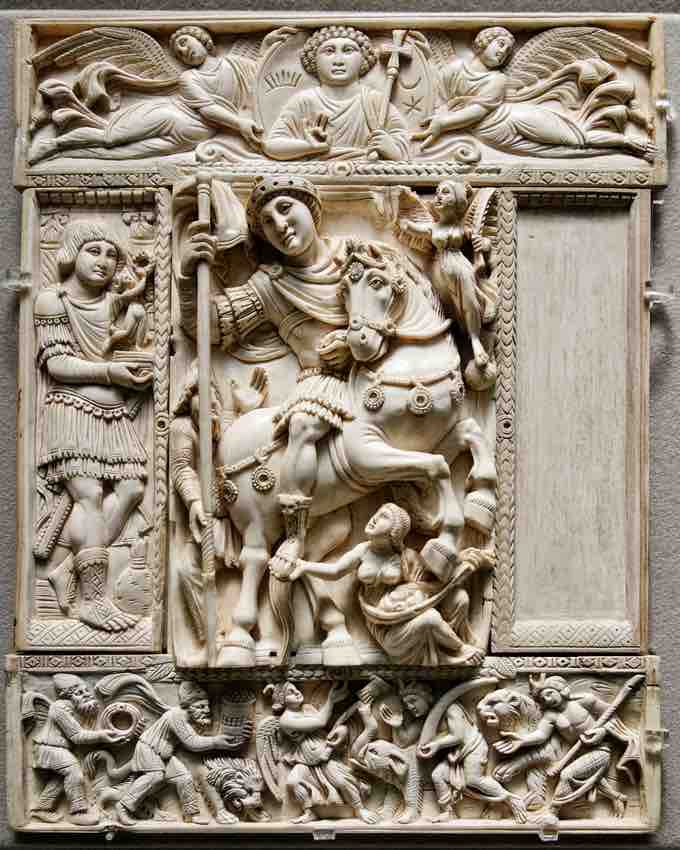The Appeal of the Miniature
Ivory carving is the manual or mechanical carving of either animal tooth or tusk, wherein very fine detail can be achieved, and the surviving works often demonstrate intricate and complicated designs. This art form has a special importance to the history of Byzantine art because it has no bullion value and is not easily recycled like precious metals or jewels. Because of this, many ivory carvings from the Early Byzantine period still survive. Ivory diptychs, often elaborately decorated, were issued as gifts by newly appointed consuls.
In the Early Christian period, Christians avoided monumental sculpture, which was associated with the old pagan Roman religion and sculpted almost exclusively in relief. During the persecution of Christians, such reliefs were typically kept small in scale, no larger than the reliefs on sarcophagi. Objects that were small-scale and lightweight are more easily carried and hidden, attributes that a persecuted class worshiping in secret would have found necessary. When Christianity was legalized and later, became the official religion of the Empire, these attitudes remained. As a result, small-scale sculpture—for which ivory was in many ways the best material—was central to art in a way that it rarely was at other times.
Consuls, civil officers who played an important administrative role until 541, gave Roman Consular diptychs as presents. The form was later adopted for Christian use, with images of Christ, the Theotokos (the Virgin Mary), and saints. Such ivory panels were used as treasure bindings (elaborate book covers) from the sixth century, usually as centerpieces, and surrounded by metalwork and gems. These book covers were sometimes assembled from up to five smaller panels due to the limited width of the tusk. Carved ivory covers were used as treasure bindings on the most precious illuminated manuscripts.
The Barberini Diptych
The Barberini Diptych (c. 500-550 CE) is a Byzantine ivory leaf from an imperial diptych dating from Late Antiquity. It is carved in the style known as Late Theodosian, representing the emperor as triumphant victor .

Barberini Diptych
The Barberini Diptych is an early example of Byzantine ivory work. Musée du Louvre, Paris. c. 500-550 CE.
The Barberini Diptych is attributed to an imperial workshop in Constantinople. The emperor depicted, however, is usually identified as Justinian, or possibly Anastasius I or Zeno. Although it is not a consular diptych, it shares many features of their decorative schemes. The emperor is accompanied in the main panel by a conquered barbarian in trousers at left, a crouching allegorical figure, probably representing territory conquered or reconquered, who holds his foot in gratitude or submission, and an angel or victory crowning the emperor with the traditional palm of victory, which is now lost. The spear that partially conceals the barbarian does not wound him. He seems more astonished and overawed than combative. Above, Christ, with a fashionable curled hairstyle, is flanked by two more angels in the style of pagan victory figures. He reigns above, while the emperor represents him below on Earth. In the bottom panel barbarians from West (left, in trousers) and East (right, with ivory tusks, a tiger and a small elephant) bring tribute, which includes wild animals. The figure in the left panel, apparently not a saint but representing a soldier, carries a statuette of Victory; his counterpart on the right is lost.
The Archangel Ivory
Dating to approximately the same period as the Barberini Diptych is the Archangel Ivory (c. 525-550 CE), the largest surviving half of an ivory diptych from the Early Byzantine period. The subject matter is an archangel, possibly Michael, who holds a scepter in his left hand and an orb capped with a cross in his right hand, which he extends in a gesture of offering. This is the insignia of imperial power. Above the angel hovers a Greek cross surrounded by a laurel wreath, possibly signifying victory. Its missing half might have depicted Justinian I, to whom the archangel would be offering the insignia. With the Barberini Diptych, it is one of two important surviving sixth-century Byzantine ivories attributed to the imperial workshops of Constantinople under Justinian.
Archangel Ivory
Constantinople. British Museum. c. 525-550 CE.
The figure is depicted in a highly classical style, wearing Greek or Roman garb and with a youthful face and proportions conforming to the ideals of classical sculpture. Although the architectural elements consist of a classical round arch supported by Composite columns, the space is more typically Byzantine in its bending of spatial logic. The archangel's feet are at the top of a staircase that recedes from the base of the columns, but his arms and wings are in front of the columns. His feet are also not firmly planted on the steps.
The top of the ivory bears a Greek inscription that translates as, "Receive this suppliant, despite his sinfulness," possibly an expression of humility on the part of Justinian. Interpreted as the beginning of an inscription that continues on the lost second panel, which might read, "Receive these gifts, and having learned the cause..."
In the Byzantine and Eastern Orthodox world, the disapproval of large religious sculpture was to remain unchanged to the present day. However, in the West it was overcome, probably beginning with the court of Charlemagne in the ninth century. As large monumental sculpture in other materials became more important, the centrality of ivory carving slowly lessened.